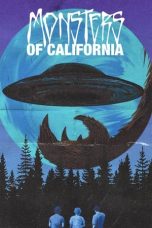- Source: Inyo County, California
Inyo County ( ) is a county in the eastern central part of the U.S. state of California, located between the Sierra Nevada and the state of Nevada. In the 2020 census, the population was 19,016. The county seat is Independence. Inyo County is on the east side of the Sierra Nevada and southeast of Yosemite National Park in Central California. It contains the Owens River Valley; it is flanked to the west by the Sierra Nevada and to the east by the White Mountains and the Inyo Mountains. With an area of 10,192 square miles (26,400 km2), Inyo is the second-largest county by area in California, after San Bernardino County. Almost half of that area is within Death Valley National Park. However, with a population density of 1.8 people per square mile, it also has the second-lowest population density in California, after Alpine County.
History
Present-day Inyo county has been the historic homeland for thousands of years of the Mono, Timbisha, Kawaiisu, and Northern Paiute Native Americans. The descendants of these ancestors continue to live in their traditional homelands in the Owens River Valley and in Death Valley National Park.
Inyo County was formed in 1866 out of the territory of the unorganized Coso County, which had been created on April 4, 1864, from parts of Mono County and Tulare County. It acquired more territory from Mono County in 1870 and Kern County and San Bernardino County in 1872.
For many years it has been commonly believed that the county derived its name from the Mono tribe's name for the mountains in its former homeland. Actually the name came to be thought of, mistakenly, as the name of the mountains to the east of the Owens Valley when the first whites there asked the local Owens Valley Paiutes for the name of the mountains to the east. They responded that that was the land of Inyo. They meant by this that those lands belonged to the Timbisha tribe headed by a man whose name was Inyo. Inyo was the name of the headman of one of the Timbisha bands at the time of contact when the first whites, the Bennett-Arcane Party of 1849, wandered, lost, into Death Valley on their expedition to the gold fields of western California. The Owens Valley whites misunderstood the reference and thought that Inyo was the name of the mountains when actually it was the name of the chief, or headman, of the tribe that had those mountains as part of their homeland. In Timbisha, ɨnnɨyun means "it's (or he's) dangerous".
To supply the growing City of Los Angeles, water was diverted from the Owens River into the Los Angeles Aqueduct in 1913. The Owens River Valley cultures and environments changed substantially. From the 1910s to 1930s the Los Angeles Department of Water and Power purchased much of the valley for water rights and control. In 1941 the Los Angeles Department of Water and Power extended the Los Angeles Aqueduct system farther upriver into the Mono Basin.
Natural history
Inyo County is host to a number of natural superlatives. Among them are:
Mount Whitney, with an elevation of 14,505 feet (4,421 m), the highest point in the contiguous United States, the 12th highest peak in the U.S., and the 24th highest peak in North America.
Badwater Basin, in Death Valley, the lowest point in North America
Methuselah, an ancient Bristlecone pine tree and one of the oldest living trees on Earth
Owens Valley, the deepest valley on the American continents
Two mountain ranges exceeding 14,000 feet (4,300 m) in elevation: The Sierra Nevada and the White Mountains
Ten of California's twelve peaks which exceed 14,000 feet (a Fourteener) in elevation; the isolated Mount Shasta in northern California, and White Mountain Peak in neighboring Mono County, are the only California 14ers not (at least partly) in Inyo County
The largest escarpment in the United States, rising from the floor of Death Valley to the top of Telescope Peak in the Panamint Range
Geography
Mount Whitney, the highest peak in the contiguous United States, is on Inyo County's western border (with Tulare County). The Badwater Basin in Death Valley National Park, the lowest place in North America, is in eastern Inyo County. The difference between the two points is about 14,700 feet (4,500 m). They are not visible from each other, but both can be observed from the Panamint Range on the west side of Death Valley, above the Panamint Valley. Thus, Inyo County has the greatest elevation difference among all of the counties and county-equivalents in the contiguous United States.
According to the U.S. Census Bureau, the county has a total area of 10,227 square miles (26,490 km2), of which 10,181 square miles (26,370 km2) is land and 46 square miles (120 km2) (0.5%) is water. It is the second-largest county by area in California and the ninth-largest in the United States (excluding boroughs and census areas in Alaska).
= Lakes
== National protected areas
=Death Valley National Park (part)
Inyo National Forest (part)
Manzanar National Historic Site
There are 22 official wilderness areas in Inyo County that are part of the National Wilderness Preservation System. This is the second-largest number of any county, exceeded only by San Bernardino County's 35 wilderness areas. Most of these are managed solely by the Bureau of Land Management, but four are integral components of Death Valley National Park or Inyo National Forest and are thus managed by either the National Park Service or the Forest Service. Some of these wilderness areas also extend into neighboring counties.
Except as noted, the wilderness areas are managed solely by the Bureau of Land Management and lie entirely within Inyo County:
= Death Valley National Park
=Death Valley National Park is a mostly arid United States National Park east of the Sierra Nevada mountain range in southern Inyo County and northern San Bernardino County in California, with a small extension into southwestern Nye County and extreme southern Esmeralda County in Nevada. In addition, there is an exclave (Devil's Hole) in southern Nye County. The park covers 5,262 square miles (13,630 km2), encompassing Saline Valley, a large part of Panamint Valley, almost all of Death Valley, and parts of several mountain ranges. Death Valley National Monument was proclaimed in 1933, placing the area under federal protection. In 1994, the monument was redesignated a national park, as well as being substantially expanded to include Saline and Eureka Valleys.
It is the hottest and driest of the national parks in the United States. It also features the second-lowest point in the Western Hemisphere and the lowest point in North America at the Badwater Basin, which is 282 feet (86 m) below sea level. It is home to many species of plants and animals that have adapted to this harsh desert environment. Some examples include Creosote Bush, Bighorn Sheep, Coyote, and the Death Valley Pupfish, a survivor of much wetter times. Approximately 95% of the park is designated as wilderness. Death Valley National Park is visited annually by more than 770,000 visitors who come to enjoy its diverse geologic features, desert wildlife, historic sites, scenery, clear night skies, and the solitude of the extreme desert environment.
= Other parks
=Alabama Hills Recreation Area
Last Chance Meadow Research Natural Area
California Bighorn Sheep Zoological Area
Demographics
= 2020 census
== 2011
=Places by population, race, and income
= 2010 Census
=The 2010 United States Census reported that Inyo County had a population of 18,546. The racial makeup of Inyo County was 13,741 (74.1%) White, 109 (0.6%) African American, 2,121 (11.4%) Native American, 243 (1.3%) Asian, 16 (0.1%) Pacific Islander, 1,676 (9.0%) from other races, and 640 (3.5%) from two or more races. Hispanic or Latino of any race were 3,597 persons (19.4%).
= 2000
=At the 2000 census, there were 17,945 people, 7,703 households and 4,937 families residing in the county. The population density was 2 per square mile (0.77/km2). There were 9,042 housing units at an average density of 1 per square mile (0.39/km2). The racial makeup of the county was 80.1% White, 0.2% Black or African American, 10.0% Native American, 0.9% Asian, 0.1% Pacific Islander, 4.6% from other races, and 4.2% from two or more races. 12.6% of the population were Hispanic or Latino of any race. 16.4% were of German, 12.2% English, 10.6% Irish and 5.0% American ancestry according to Census 2000. 89.2% spoke English and 9.3% Spanish as their first language.
There were 7,703 households, of which 27.9% had children under the age of 18 living with them, 49.8% were married couples living together, 9.9% had a female householder with no husband present, and 35.9% were non-families. 31.4% of all households were made up of individuals, and 13.6% had someone living alone who was 65 years of age or older. The average household size was 2.31 and the average family size was 2.88.
24.4% of the population were under the age of 18, 5.8% from 18 to 24, 23.4% from 25 to 44, 27.3% from 45 to 64, and 19.1% who were 65 years of age or older. The median age was 43 years. For every 100 females there were 95.4 males. For every 100 females age 18 and over, there were 92.9 males.
The median household income was $35,006 and the median family income was $44,970. Males had a median income of $37,270 versus $25,549 for females. The per capita income for the county was $19,639. About 9.3% of families and 12.6% of the population were below the poverty line, including 16.0% of those under age 18 and 8.3% of those age 65 or over.
Politics
= Voter registration
=Cities by population and voter registration
= Overview
=Inyo has historically been a strongly Republican county in Presidential and congressional elections. From 1944 to 2016, the only Democrat to win the county (and the last to win a majority of its vote) was Lyndon Johnson in 1964.
However, the county shifted significantly leftward in 2020, narrowly supporting Joe Biden over Donald Trump. As a result, it became one of only two counties that previously voted for Trump by double digits in 2016 to flip to the Democrats, the other being Talbot County, Maryland.
Inyo still leans Republican. It voted Republican in all statewide races held in 2022. It flipped back to voting for Donald Trump in 2024, though by a much smaller margin than Trump had won the county in 2016.
In the California State Legislature, Inyo County is in the 4th Senate District, represented by Republican Marie Alvarado-Gil, and the 8th Assembly District, represented by Republican Jim Patterson.
The county is in California's 3rd congressional district, represented by Republican Kevin Kiley.
On November 4, 2008, Inyo County voted 60.6% for Proposition 8 which amended the California Constitution to ban same-sex marriages.
The county was home to Manzanar Internment Camp, where Japanese Americans were interned during World War II. Although the county was typically Democratic before World War II, in the decades since Japanese internment the county has been solidly Republican, only voting for Lyndon Johnson (who signed the Civil Rights Act of 1964) and Joe Biden (who ran on a ticket with Kamala Harris, the first Asian American to be part of a major party ticket).
Crime
The following table includes the number of incidents reported and the rate per 1,000 persons for each type of offense.
= Cities by population and crime rates
== County Sheriffs
=W. A. Greenly (Mar 22, 1866- November 7, 1867)
William A. Moore (Nov 7, 1867- November 7, 1875)
Thomas Passmore (Nov 7, 1875- February 10, 1878)- Killed On Duty
William A. Moore (Feb 10, 1878- July 4, 1879) - Killed On Duty
Stephen G. Gregg (Jul 4, 1879- November 7, 1888)
Fred Charles Scott (Nov 7, 1888- November 7, 1896)
Charles Albert Collins ( Nov 7, 1896- November 7, 1916)
Boone Newett (Nov 7, 1916- November 7, 1918)
Frank Logan (Nov 7, 1918- November 7, 1924)
Charles Albert Collins (7 Nov 1924-7 Nov 1926)
Tom Hutchinson (Nov 7, 1926- November 7, 1934)
Emmett L. Shay (Nov 7, 1934- November 7, 1942)
Charles P. Cline (Nov 7, 1942- November 7, 1954)
Merrill Howard (Nov 7, 1954- November 7, 1960)
Merrill Franklin Culbertson (Nov 7, 1960- November 7, 1962)
Merrill L. Curtis (Nov 7, 1962- November 7, 1970)
Floyd Barton (Nov 7, 1970- November 7, 1982)
Floyd Tidwell (Nov 7, 1982- November 7, 1984)
Don Dorsey (Nov 7, 1984- November 7, 1996)
Dan Lucas ( Nov 7, 1996- November 7, 2006)
William R. "Bill " Lutze (7 Nov 2006–2018)
Stephanie J. Rennie (Jan 3, 2023 - Current)
Education
School districts in Inyo County are:
Big Pine Unified School District
Bishop Unified School District
Bishop Union High School District
Bishop Union Elementary School District
Death Valley Unified School District
Lone Pine Unified School District
Owens Valley Unified School District
Round Valley School District
Deep Springs College is a two-year alternative education college in Deep Springs Valley.
Higher education in Inyo County is provided by the Kern Community College District.
Notable locations
Mushroom Rock
Mount Whitney
Death Valley National Park
Badwater Basin
Lake Manly
Furnace Creek, California (Hottest air temperature ever recorded here in 1913 at 134.6 °F (57.0 °C). In July 1972, a ground temperature of 201 °F (94 °C) was measured in Furnace Creek. This may be the highest natural ground surface temperature ever recorded.)
Transportation
In the 1920s, automobile clubs and nearby towns started to lobby for trans-Sierra highways over Piute Pass and other locations. However, by end of the 1920s, the Forest Service and the Sierra Club decided that roadless wilderness in the Sierra was valuable, and fought the proposal. The Piute Pass proposal faded out by the early 1930s, with the Forest Service proposing a route over Minaret Summit in 1933. The Minaret Summit route was lobbied against by California's Governor Ronald Reagan in 1972. The expansion of the John Muir and Ansel Adams Wildernesses in the 1980s sealed off the Minaret Summit route.
A trans-Sierra route between Porterville and Lone Pine was proposed by local businessmen in 1923. Eventually, a circuitous route across the Sierra was built across the only trans-Sierra route south of Yosemite: Sherman Pass by 1976. That route is Forest Route 22S05 to the west, and Kennedy Meadow Road (County Route J41) and 9-Mile Canyon Road to the east.
= Major highways
=U.S. Route 6
U.S. Route 395
State Route 127
State Route 136
State Route 168
State Route 178
State Route 190
= Public transportation
=Eastern Sierra Transit Authority operates intercity bus service along US 395, as well as local services in Bishop. Service extends south to Lancaster (Los Angeles County) and north to Reno, Nevada.
= Airports
=Bishop Airport, Independence Airport, Lone Pine Airport and Shoshone Airport are general aviation airports located near their respective cities. Stovepipe Wells Airport and Furnace Creek Airport are located in Death Valley National Park.
Communities
= Cities
=Bishop
= Census-designated places
== Other unincorporated communities
=Source:
Alabama Hills
Chicago Valley
Coso Junction
Death Valley Junction
Deep Springs
Dunmovin
Haiwee
Laws
Panamint Springs
Sandy Valley
Stewart Valley
= Population ranking
=The population ranking of the following table is based on the 2010 census of Inyo County.
† county seat
See also
National Register of Historic Places listings in Inyo County, California
Notes
References
External links
Inyo County Tourism website
Eastern California Museum
Kata Kunci Pencarian:
- Bishop, California
- Cekungan Badwater
- County San Diego (California)
- Trilobit
- Batu berjalan
- Daftar rumah sakit di California
- Daftar county dan daerah setingkat county di Amerika Serikat
- Manzanar
- Marvel Cinematic Universe: Fase Satu
- Proposition 8
- Inyo County, California
- Independence, California
- Tecopa, California
- Trona, Inyo County, California
- Furnace Creek, California
- Inyo
- Olancha, California
- List of school districts in California
- Bishop, California
- Darwin, California
The Bad News Bears (1976)
Paul (2011)
Pulp Fiction (1994)
Inception (2010)
No More Posts Available.
No more pages to load.














